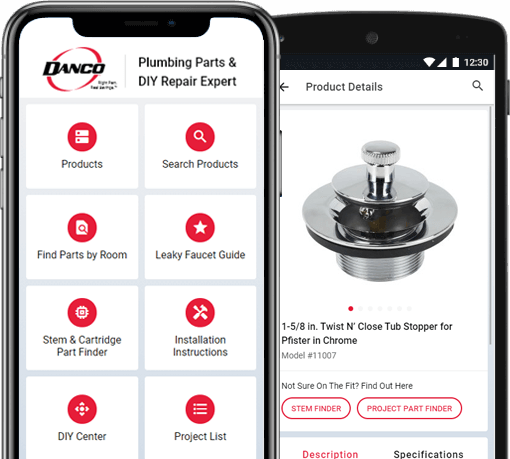Plumbing 101
November 28, 2015Aerator:
It is often found at the tip of an indoor water faucet. An aerator can be simply screwed onto the faucet head. It adds air to the water before it comes out of the faucet so that the water will flow in a single, non-splashing stream. It helps to create better water flow in properties that suffer from low water pressure. It also serves as a way to reduce the level of water consumption, as it creates higher water pressure. Due to the aerator spreading the water flow, less water leaves the faucet.
Antimicrobial Product Protection:
Is an added feature that offers built-in antimicrobial protection, fighting the growth of odor causing bacteria, mold and mildew
Ball(Control Faucet):
Uses a ball with a stem to control water flow. As the handle is moved, the ball turns and lines up with parts in the faucet body, allowing the water to flow.
Ballcock Supply Valve:
Water supply valve. It fills the tank with water and is one of the two major components necessary for a toilet tank to function (also called Fill Valve or Refill Valve). It features a float ball on the end of an arm that rises with the water level to shut off the valve.
Basin Wrench:
Sometimes called a sink wrench, is a plumbing tool that is used in confined spaces to turn fasteners that would be difficult or impossible to reach with a plumber's wrench or other types of wrenches. For example, the threaded nuts used to secure faucets to sinks are often located in deeply recessed places that can only be accessed with a basin wrench.
Bidet:
A personal hygiene fixture or attachment with cold (and sometimes hot) water supply intended for genital and personal cleanliness.
Cartridge:
Controls the flow of the water through the faucet. A cartridge is mostly used to control the flow of water through a single handle faucet, though some of the more current 2 handle faucets use cartridges as well.
Centerset:
Refers to types of faucets where the hot and cold handle are close together next to the spout. Center set faucets are typically 4" between the center of the hot and cold handle.
Closet Flange:
Is a pipe fitting that both mounts a toilet to the floor and connects the toilet drain to a drain pipe. The flange is a round steel mounting ring that sits on top of the pipe fitting. The toilet is bolted onto the flange (also called Floor Flange or Toilet Flange).
Disc Cartridge:
Uses ceramic discs to control the flow of water, rather than compressing a washer against a seat.
Dual Flush:
Eliminates the flapper and chain and converts toilets to a water saving dual flush design. It uses two buttons or split handles to flush different levels of water.
Electronic Flush Valves:
Provides touch-free flushing. The electromagnetic field activates the flush when a hand is placed above it.
Escutcheon:
A decorative piece intended to cover rough plumbing, such as the pieces that cover faucet stems.
Fill Valve:
The hardware inside the toilet tank that controls how much water fills the tank. Can be a ballcock or float cup style. Most new versions of fill valves are available with water-saving features.
Flapper:
Rubbery plug/seal attached to the lift chain at the bottom of your toilet water tank (also called stopper, tank-ball, seal or disk).
Float ball:
The ball that rides on the surface of the water in the tank. When the tank is full, the float ball shuts off the ballcock.
Float Cup Fill Valve:
The float cup fill valve is made of plastic and is a more “modern” style anti-siphon fill valve. Water flow is controlled by a plastic floating O-shaped cup that moves up and down concentrically about the fill valve shaft that raises the float arm, shutting off the valve.
Floatless Type Ballcock:
The floatless ballcock is made of plastic and is a newer innovation in anti-siphon fill valves. These units use a diaphragm pressure sensing mechanism as opposed to any type of float mechanism to adjust water level in the toilet tank.
Floor Flange:
Is a pipe fitting that both mounts a toilet to the floor and connects the toilet drain to a drain pipe. The flange is a round steel mounting ring that sits on top of the pipe fitting. The toilet is bolted onto the flange (also called Closet Flange or Toilet Flange).
Floor Register:
A register is a grill with moving parts, capable of being opened and closed and the air flow directed, which is part of a building's heating, ventilation, and air conditioning (HVAC) system. Floor registers are used on the floor, as opposed to wall registers.
Flush Lever:
Located on either the left or right hand side of the toilet tank; it activates the trip lever arm to initiate the flushing cycle in order to flush out the contents of the toilet (also called toilet handle or trip lever handle).
Flush Valve:
The part inside the tank of the toilet that moves the water into the bowl. It releases the stored water into the toilet bowl for flushing.
GPF:
Gallons per Flush. An indicator of how efficient a toilet is. Most modern toilets are 1.6 or 1.28 GPF.
GPM:
The flow rate of a faucet or shower head is measured in Gallons per Minute (GPM) and is a critical factor in sizing a tankless water heater or for evaluating if an older plumbing fixture is wasting water.
Handle Broach:
A broach is located on the inside of a handle. The faucet stem should fit snug inside the handle broach. A deep broach is closer to the top of the handle, while a shallow broach is closer to the bottom of the handle.
Lift Chain:
Connector composed of a series of metal links that, when pulled up by the trip lever, opens the tank ball or flapper.
Main Drain/Waste pipe:
The slanting pipe in the basement or crawl space that carries wastes to a sewer or septic tank; also called building drain.
NPS:
Is a straight thread used for mechanical joints or where fluid sealing is accomplished by an o-ring or washer at the base of the threads. NPS is a U.S. standard.
O-Ring:
A gasket in the form of a ring with a circular cross section, typically made of pliable material, used to seal connections in pipes, tubes, etc.
Overflow Tube:
A Long, hollow tube, fastened to the bottom of a toilet tank. The overflow tube limits how much water can be put in the tank, and should always be shorter than the height of the hole the tank lever passes through.
Packing Nut:
Metal part allowing the packing to be tightened against the stem. If the packing nut is too loose, the stem will leak; if it is too tight, the stem will be hard to turn.
Plunger / Piston Type Ballcock:
This ballcock/fill valve uses a rod and float to fill the tank with water. This style of ballcock uses a characteristic bottom-fill water discharge tube and is designed with a hinged lever assembly above the ballcock which often use thumbscrews at some hinged joints to allow adjustment of lever arm movement.
Proposition 65:
Officially known as the Safe Drinking Water and Toxic Enforcement Act of 1986, requires the state to maintain and update a list of chemicals known to the state. Enacted as a voter initiative in November 1986 with an approved vote of 63-37 percent margin, Proposition 65 protects the state’s drinking water sources from being contaminated with chemicals that are known to cause cancer, birth defects, or other reproductive harm. The warning has to be given for products sold in California that contain any one of over 900 chemicals of concern regardless of the amount of the chemical in the product. The list, which is updated at least annually, includes a wide variety of chemicals that can be found in many consumer products, such as kitchen utensils, footwear, handbags, exercise equipment, photo and scrapbook albums, plumbing products, luggage, and many other products (even foods and beverages).
Refill Valve:
Water supply valve. It fills the tank with water and is one of the two major components necessary for a toilet tank to function (also called Fill Valve or Ballcock Supply Valve).
Seat:
A brass or rubber piece used in faucets to provide a smooth clean surface for a stem to seal against.
Shutoff valve:
A device for shutting off the supply of water to the toilet or faucet. The valve will allow you to shut off the water to one sink or toilet without disrupting the flow to others, but they'll also provide a quick way to turn off the water in the event of a cracked pipe fitting or ruptured supply tube.
Single Handle Faucet:
Features one handle that controls the flow of hot and cold water. It can have 2 types of internal mechanisms (cartridges) for controlling water flow and temperature: ball cartridge or disc cartridge.
Spud:
A threaded waterway assembly inserted into the fixture for assembly of valves or trim. (Back spud - pipes are concealed behind wall. Top spud - pipes are exposed.)
Stem Faucet:
Controls the flow of the water through the faucet. A stem is only found in a 2 handle faucets.
Stem Washer:
Stopper attached to the bottom of the spindle. When inserted into the valve seat, it blocks the inflow of water; when raised, it allows the water to flow. (also called Bibb washers)
Stem:
The plumbing device inside a faucet fixture that stops and starts the flow of hot or cold water, as well as regulates its flow rate.
Strainer:
Device used to trap foreign materials, preventing blockage of the water passageway in urinals, bathtubs, showers, or sinks.
Tank ball:
Plug that, when raised by the lift chain, lets the water in the tank flow into the toilet bowl; it then sinks, allowing the tank to refill.
Thread:
Helical grooves at the end of the spout to which an accessory, such as an aerator, can be attached.
Toilet Flange:
Is a pipe fitting that both mounts a toilet to the floor and connects the toilet drain to a drain pipe. The flange is a round steel mounting ring that sits on top of the pipe fitting. The toilet is screwed onto the flange (also called Closet Flange or Floor Flange).
Toilet Handle:
Located on either the left or right hand side of the toilet tank; it activates the trip lever arm to initiate the flushing cycle in order to flush out the contents of the toilet (also called trip lever handle or flush handle).
Toilet Rough-in measurement:
Dimension from finished wall or floor to center of waste or supply opening or mounting holes. (Most one and two piece toilets are 12" rough. Some compact toilets are 10" rough.)
Top mount:
The whole faucet fits through the holes on the top of the sink with a plate covering the body of the faucet.
Trap:
A bent section of a waste pipe, usually in the shape of a J, S, or P, that fills with water to keep sewer gases from coming back up the waste pipe.
Trip lever:
Mechanism that, when activated by the flush handle, pulls up the lift chain, letting the water flow from the tank into the toilet bowl.
Two Piece Toilet:
The toilet tank and bowl are molded separately with the need for attachment through the use of tank to bowl bolts.
Undermount Faucet:
The body of the faucet mounts from under the sink and the trim goes on from the top.
Vacuum Breaker:
A device to prevent water standing in a basin or container from being drawn back into your water supply if there is a complete loss of water supply pressure. A siphon can occur if the end of a hose, hand spray or spout is below the liquid’s surface, pulling contaminated water into the building’s water supply pipes.
Wax Ring/Seal/Gasket:
As traditional toilets are secured by being bolted to the flange, the seal/ring is used to seal the gap between the flange and the bottom of the toilet, in order to prevent sewage gas leaking.
- All
- Products
- General Plumbing Repair
- Faucet Repair
- Warranty
- Proposition 65
- Toilet Repair









